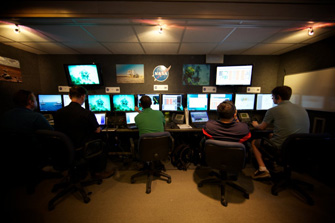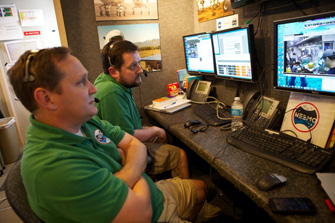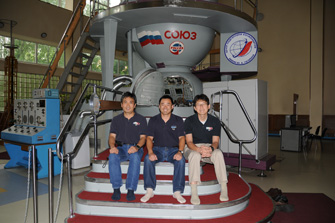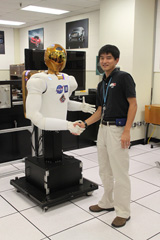JAXA Astronaut Activity Report, June, 2012
Last Updated: September 11, 2012
This is JAXA's Japanese astronaut primary activity report for June, 2012.
Astronaut Hoshide's final training before the launch from Russia
In early June, as Astronaut Hoshide completed his final operational training and experiments on the Columbus module of the European Space Agency (ESA), he moved to the Gagarin Cosmonaut Training Center (GCTC) in Russia, along with cosmonaut Yuri Malenchenko and astronaut Sunita Williams, Hoshide's crewmates for Expedition 32/33 missions, where they received their final training on the Russian segment of the International Space Station (ISS) and Soyuz spacecraft.

Hoshide and his crewmates receive a final examination (Credit: JAXA/GCTC)
The final training mostly simulates real operations, including responses to various contingencies during launch and the return to Earth and simulation of the daily operations performed in the Russian segment. In addition, the crew's tasks specific to the Expedition 32/33 missions were again practiced, including the operations required to undock the Automated Transfer Vehicle (ATV). At the GCTC, they also obtained their basic medical data for medical experiments.
Additionally, Hoshide and his crewmates visited TsUP, the Mission Control Center of the Russian Federal Space Agency (FSA), located in the Moscow suburb of Korolyov, where they discussed mission plans, the current operational status of the Russian segment, and routine crew tasks to be performed on the ISS with the Flight Controllers.

Hoshide and his 31S crewmates grasp hands at the completion of a prelaunch news conference (Credit: JAXA/NASA)
On June 19 and 20, they underwent a final examination on the Russian segment and Soyuz spacecraft at the GCTC and passed with an excellent result, whereupon they were officially certified as the crew of the Soyuz Spacecraft (31S) by the FSA.
On June 22, they took part in a press conference at the GCTC. Hoshide expressed his feelings just ahead of his ISS extended mission and his aspirations for the same. After the press conference, they participated in the traditional prelaunch ceremony, visiting a museum in Star City and the Kremlin in Moscow.
Astronaut Wakata undergoes training in Russia for the ISS extended mission
Astronaut Wakata, assigned as an ISS Expedition 38/39 crew member, visited the GCTC in Russia and was trained in the system and operations of the Russian segment and Soyuz spacecraft.
Wakata received a lecture concerning the daily operations performed in the Russian segment during ISS missions, such as the inventory management system to monitor goods on the ISS, and the usage of LAN in the Russian segment. Wakata also received a lecture on the Operations Data File (ODF) to be referred to when handling onboard hardware in the Russian segment. In addition to crucial knowledge required for daily operations, he trained in preparation for contingencies such as fire.
Using the Soyuz spacecraft simulator, Wakata reviewed operations for each flight stage, from launch to orbit insertion, rendezvous, and docking to the ISS; for example, reviewing the process to check the status of onboard hardware before performing a maneuver to adjust the height and approach the ISS.

Wakata and his crewmates pose for a photo at the water survival training (Credit: JAXA/GCTC)
In mid-June, Wakata and the Expedition 38/39 crew members Mikhail Turin and Richard Mastracchio participated in the water survival training held in the EMERCOM facility in Noginsk, a Moscow suburb, to be prepared in case the Soyuz spacecraft was forced to make an emergency landing on water, e.g. at sea.
During the training, the three future crewmates boarded the descent module mockup (a full-scale training facility) of the Soyuz spacecraft floating on the water. They reviewed how to change from the Sokol spacesuits to waterproof snowsuits and then evacuate from the closed module waving on the water.
Furthermore, they also learned how to escape from the module, stocking the most basic items within a limited time, assuming post-splashdown flooding. They also practiced communicating with a rescue team and how to make a trilateral formation on the water.
Astronaut Kanai trains in Russia for the Soyuz spacecraft

Sitting on the seats of the descent module simulator of the Soyuz spacecraft, JAXA's astronaut trio Wakata (right), Hoshide (center), and Kanai (left) pose for a photo. They happened to meet at the GCTC for training.
Continuing from May to mid-June, Astronaut Kanai underwent training at the GCTC, focusing on the system and operations of the Soyuz spacecraft.
Kanai thoroughly read the ODF to be used during space flight by the Soyuz spacecraft and confirmed the crew's tasks at each operational stage. Specifically, Kanai checked the last-minute tasks at the launch pad and operations during and right after orbit insertion. Using a simulator, Kanai learned the crew's operations at each phase, by activating the Soyuz spacecraft during the docked phase and its undocking procedure, reentry, and landing on Earth. In addition, through lectures Kanai learned about the life support system, medical support system and even attended a lecture regarding the Launch Escape System (LES) of the Soyuz rocket.
They also trained on how to respond to fire and depressurization in the Russian segment using a full-scale ISS mockup.
Astronaut Yui participated in the NEEMO 16

Yui and the other NEEMO 16 members (Credit: JAXA/NASA)
From June 11 to 22 (U.S. time), astronaut Yui underwent the 16th NASA Extreme Environment Mission Operations (NEEMO 16).
The NEEMO 16 was conducted to foster leadership, teamwork and self-management skills by co-habitation within the closed facility called AQUARIUS, the underwater laboratory located off the coast of Florida at a depth of about 20 meters, the extreme environment of which resembles that of space flight. NEEMO 16 also aims to develop new technology and operational skills for the ISS and asteroid exploration missions.
New Astronauts at the Front-Line

I would like to say thank you all for your encouragement during the NEEMO training. I received support from so many people. I believe I was fortunately able to achieve great results in various aspects.
So, which topic shall I tell you today? One of topics I could not have explained sufficiently in this journal is delay of communication. In the NEEMO mission, we simulated 50-seconds communication delay for one way, assuming a situation exploring an asteroid located at about a tenth distance of the distance between the earth and the sun. (It takes such a long time even at the light speed.) And we examined which tools should we use for communication under such situation. It is OK, if everything goes well according to a plan. But once emergency situation occurs, it become serious unless appropriate methods were established in advance. Professionals in communication are assembled to the space development field, the police and fire departments, and the Self-Defense Forces of Japan. This is because inadequacy of communication could directly affect somebody's life.
I am not an expert of communication, but there is something that I always think about how to deal with information. Today, I would like to tell what I am always thinking about basic idea of communication.
Of course faster and accurate communication is better. However, it is rare to achieve both of them at the same time. Maybe you can request it faster and accurate when you want to receive information immediately, but you cannot complain if the information is a little bit inaccurate. If you want really accurate information, it takes time to analyze and confirm the information. So, you cannot complain if there is some delay.
As a matter of fact, information can be made the best use of when the information is used for some kind of purposes. It is important that needed information is provided timely and to proper places, and used for decision making. So, it is important to analyze methods of information analysis, conveyance speed, where to be conveyed, etc. in advance assuming what could be happened when the communication is delayed or inaccurate. When you think about this, do you notice that there is less necessity to convey good news faster? When good things occur, you have nothing need to do immediately because the things do not become worse even if you leave it unattended. The worse the news is the earlier people need to communicate it. However, this is very difficult. Have you ever become angry when you hear bad news or wrong reports? (For example, when your child reported that somebody else scolded him/her, when your follower reported about his/her mistake at work, or when a preliminary report was wrong) This is one of the largest causes that conveyance of bad news or information needed for timely action become delayed. When you hear a report about bad news, this is exactly the right time to compliment the person because his/her report makes it possible to act timely without leaving the situation getting worse.
Now, let me back to the story of 50 seconds communication delay. So many people told me that such communication must be very difficult because of the delay. However, I actually did not feel it so hard. Of course, when we are in audio communication, if you missed some words and asked to repeat the words, then you need to wait more than 100 seconds. Yes, it is hard. But you can avoid such problems with some means. For example, you can reduce a risk to miss words by saying "I am going to tell you very important information 10 seconds after this" to make the person prepared to listen it. Also, if immediate action is not necessary, you can send the information as a text form, such as chat or e-mail, to avoid missing the words.
This experience in the mission was a good opportunity for me to reconsider about communication.
As mentioned before, the public makes decisions of the final policy of the space development field. We may convey not only good news but also bad news for your required decision. It may take some time for the purposes of accuracy. However, we are going to try continuously to deliver necessary information for your exact decision in timely and proper manner. And, we would like to make an effort to receive the confidence of of the Japanese public. After all, communication cannot be made up without a relationship of mutual trust. Thank you for your continuous support.

This is a control center on the ground. A variety of information is collected together and timely and proper decisions are made in this room.

(Simulation) Red alert! Communication delay is affecting on cooperation with the ground!

In some cases, ground staff needs to leave site staff their own decision when it is difficult for the ground staff to make a decision.
*Photos are sourced from JAXA/NASA.

Do you know a word "Robonaut"?
This word is a coined word originated from a combination of Robot and Astronaut. So, "robonaut" means a robot astronaut, as you see.
From a word "robot", many people may imagine humanoid robots as typified by Astroboy. Actually, the word "robot" is said to have more broad meaning, and to be used to refer to devices that carry out tasks instead of human. Many robots are actively involved in our society, for example industrial robots. As you know, cleaning robots are very popular these days. There is no doubt that this is an example of robots that carries out a task, cleaning, instead of human.
When you look at the the space field, there many robots are also actively involved. In the International Space Station (ISS), two robot arms respectively developed by Japan and Canada are currently carrying out tasks such as assembly of the ISS, and transfer and installation of experimental equipment. On top of that, the robot arm is also performing a literal spectacular feat, grabbing a Japanese transfer vehicle "KOUNOTORI".
In addition, NASA's Mars rover named Opportunity, that currently stays active on Mars and is sending precious scientific data to the earth, is one of robotic space probes.
One day in June, Professor Kazuya Yoshida of Tohoku University who studies these space robots visited NASA to give a seminar. He also visited NASA's robot-related facility at that time. Fortunately I accompanied the tour with him and had a valuable experience. I would like to write about my experience at the tour.
Now, let me back to a story about robonauts.
Actually, the robonauts have already been transported to the ISS by American space shuttle in the last year.
This is a photo of the same type robonaut for ground tests. This robonaut has no lower body, but its upper body looks like human itself. It seems to move using batteries in a backpack having on its back.
It seems that cameras on the head can recognize exact shape of object. For example, if I held out an envelope, the robonaut showed us a movement to receive it.
Furthermore, when I lightly held its hand, the robonaut recognized it as a handshake from a human and surprisingly it squeezed back.
This movement of handshake is looks quite simple, but actually it is very complicated and very human movement.
First, sensors embedded in a palm recognize that its hand is held.
Then, the brain that recognized it sends back an order to squeeze the hand back to the body.
Receiving the order, the body squeezes the hand back with moderate force by activating individual actuators of a brachial region and then fingers.
This "with moderate force" is a very important point. We, humans do this unconsciously; however, if it is too weak it does not become a handshake. On the contrary, if it is too strong, it could damage the hand.
Such deftness and subtlety of fingers would make it possible to carry out simple tasks such as turning screws and to support handing over tools for human astronauts.
Honestly, I thought a little bit negatively that it is impossible that robots can be used in place of human, until I saw this robonaut. But when I actually saw it moving, I changed the recognition.
Of course, I think robots cannot replace human at this point; however, I felt some potential that it is quite possible that robots support to human by utilizing the advantages of robots.
Robots can continue working without tiring with unchanging accuracy even for long-lasting simple tasks, and never complain of hunger. Best of all, robots can move outside of a spacecraft as it is. I think this will be a great advantage of robots.
In my favorite move "Star Wars", robots like R2-D2 and C-3PO do splendid works. Such situation may become a reality in the future.
As an aside, I was asked to have a test of strength with the robonaut. So, I took on the challenge as a representative of the human race.
That was a competition to hold up an iron dumbbell weighing about 10 kg with a hand stretched toward the side of the body.
A result was totally my defeat. I had no choice but to give up along the way because my joint was almost damaged in the course of lifting up the dumbbell.
Well I realized that joints of human are so weak when force is applied toward a direction that usually not used.
A guide told me that the robonaut has never been defeated.
I withdrew dejectedly, but a simple question popped out in my mind. "Wait a minute. Weight does not matter in the space because of nongravity, does it?" Well, maybe I should accept my defeat.
*Photos are sourced from JAXA/NASA.

Hello, everyone! I am a rookie astronaut, Norishige Kanai.
I have continued my training in Star City, Russia until this mid-June. I successfully finished simulations for Soyuz Spacecraft, and finally completed all scheduled training in Russia. That was a total of 12 weeks training, and I have visited Russia 3 times for the training since the end of last year.

A scene during the training in Russia with Astronauts Hoshide and Wakata who were immediately before a mission and also receiving training around the same time in Russia.
Such kind of business trips, however, is nothing compared to other astronauts. In cases of astronauts who are assigned to a mission in the International Space Station (ISS), much longer trainings in Russia are waiting for them during the 2 years training period until the flight although they are not always stay in Russia during the period.
And who are actually scheduled to complete the 2 years training and depart for the ISS in this July are JAXA Astronaut Akihiko Hoshide and NASA Astronaut Sunita Williams. I have said goodbye to them who are just before the final examination, and came back to Houston by myself. By when this journal comes up on the website, these two astronauts are launched from Baikonur Space Center in the Republic of Kazakhstan and are starting busy days in the ISS. I wish them good luck!
On the other hand, I am scheduled to receive trainings and take exams for emergency action for about 2 weeks at Johnson Space Center of NASA, and then trainings for European Lab (commonly known as "Columbus") at European Astronaut Centre in Germany in the next month. And I will be at Tsukuba Space Center in Japan two months later, and I will travel around the world including Canadian Space Agency three months later.
If you use airplane, you can fly across the Pacific and Atlantic Ocean in ten several hours and arrive at the other side of the world by the next day, and immediately start training. My favorite book in childhood was "Around the World in Eighty Days". Thanks to advancement of science and technology, nowadays we can travel around the world in 24 hours. It's really the convenient world
On the other hand, I think human body fails to follow changes caused by too much advanced technology in some situations. You must be prepared to face jet lag for a while when you go on and get back form an overseas business trip.
I easily upset my health having symptoms like summer fatigue when I come back from Russia where is always chilly even during a day to hot Huston where already have tropical days even in June.
In addition to the problems that human body fails to follow changes caused by sudden changes of time and climate, there are other problems related to medical services. For example when you are in another country and get sick or injured, you may not always be able to seek medical care like when you are in Japan because of differences in the medical systems
Before I became an astronaut, I was a medical officer of the Maritime Self-Defense Force. So, I always worried about what I should do if a sudden illness or serious injury occurs when we are in the middle of the Pacific Ocean; how to visit a local medical office when I have a patient; and how can we access to vaccination for particular infectious diseases that is not available in Japan, and so on.
Now, let's think about the life in ISS. What will happen up there?
In the ISS, everybody lives according to a time zone called the Greenwich Mean Time. It seems like they are keeping regular life when compared to the life receiving trainings with always traveling around the world.
But think about this. The ISS is moving with a high speed taking only 90 minutes to go around the earth. That means a day and night are repeatedly switched every 45 minutes. So, people wake up not because it starts to grow light, and people go to sleep not because it becomes dark. It is kind of weird.
Furthermore, sleep-wake patterns are not always the same. For example, when a spacecraft for supplies is arriving, astronauts in the ISS sometimes shift the time of sleep and wake little by little to conduct operations in hours when they usually sleep. This is called sleep shifts. A strict sleep control would be required because it is not acceptable to operate robot arms with struggling against sleepiness.
Different from the earth with seasonal changes, astronauts would never suffer from the summer heat in the ISS because temperature and humidity are always artificially controlled.
If somebody becomes sick in the ISS, nobody can seek medical care to a hospital. One of flight crew is always assigned to a person in charge of health to deal with health problems in consultation with doctors who are flight surgeons supporting the crew from the ground.
What will happen when somebody suffers from unmanageably serious disease or injury? In such cases, the person needs to return urgently taking a Soyuz spacecraft moored at the ISS. Even if you are on the earth, if you are in the middle of the ocean and had a sudden illness in the crew requiring surgery, you will request a rescue airplane or helicopter to carry the patient to a hospital on the ground. It is basically the same idea.
I have some sense that there are some similarities between medical problems related to travels and medical supports during stays in the space. I think it would be wonderful if various knowledge and studies conducted on the ground are applied for safety space trips for everybody. On the contrary, that would be great if studies and experiences obtained in the space are applied for healthcare on the ground in the future.
* Photos are sourced from JAXA/GCTC.














